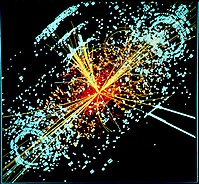
Photo from wikipedia
A bstractWe study a conformal version of the Standard Model (SM), which apart from SM sector, containing a UD(1) dark sector with a vector dark matter candidate and a scalar… Click to show full abstract
A bstractWe study a conformal version of the Standard Model (SM), which apart from SM sector, containing a UD(1) dark sector with a vector dark matter candidate and a scalar field (scalon). In this model the dark sector couples to the SM sector via a Higgs portal. The theory is scale-invariant in lowest order, therefore the spontaneous symmetry breaking of scale invariance entails the existence of a scalar particle, scalon, with vanishing zeroth-order mass. However, one-loop corrections break scale invariance, so they give mass to the scalon. Because of the scale invariance, our model is subjected to constraints which remove many of the free parameters. We put constraints to the two remaining parameters from the Higgs searches at the LHC, dark matter relic density and dark matter direct detection limits by PandaX-II. The viable mass region for dark matter is about 1–2 TeV. We also obtain the finite temperature one-loop effective potential of the model and demonstrate that finite temperature effects, for the parameter space constrained by dark matter relic density, induce a strongly first-order electroweak phase transition.
Journal Title: Journal of High Energy Physics
Year Published: 2019
Link to full text (if available)
Share on Social Media: Sign Up to like & get
recommendations!